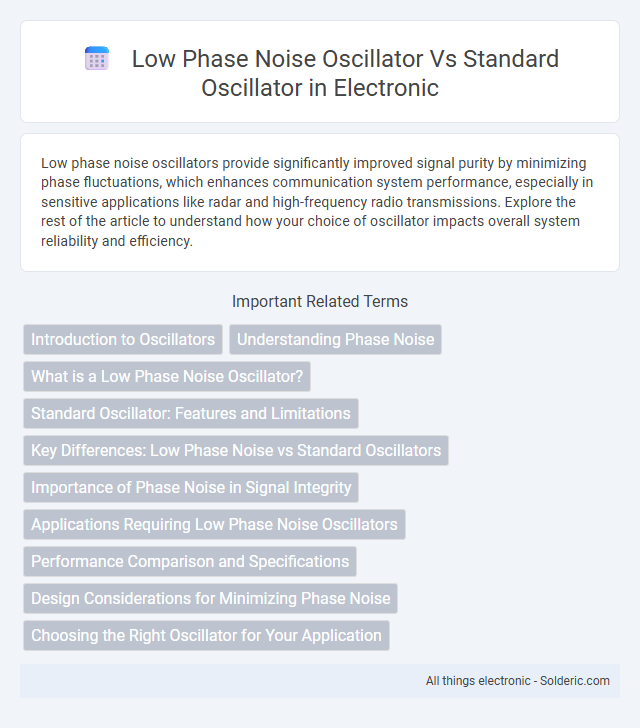Low phase noise oscillators provide significantly improved signal purity by minimizing phase fluctuations, which enhances communication system performance, especially in sensitive applications like radar and high-frequency radio transmissions. Explore the rest of the article to understand how your choice of oscillator impacts overall system reliability and efficiency.
Comparison Table
| Feature | Low Phase Noise Oscillator | Standard Oscillator |
|---|---|---|
| Phase Noise Level | Extremely low phase noise for high signal purity | Moderate to high phase noise |
| Frequency Stability | High frequency stability over temperature and time | Standard frequency stability |
| Applications | Precision communication systems, radar, high-end test equipment | General purpose electronic devices and low-cost applications |
| Signal Quality | Superior spectral purity with minimal jitter | Basic signal quality with noticeable jitter |
| Cost | Higher manufacturing and component cost | Lower cost and widely available |
| Power Consumption | Moderate to high, depending on design | Typically lower power consumption |
| Size | Often larger due to advanced components | Compact and simple design |
Introduction to Oscillators
Oscillators generate periodic signals essential in communication systems, with low phase noise oscillators minimizing signal distortion and jitter for enhanced signal integrity. These oscillators stabilize frequency output, improving performance in applications such as RF transmitters and precision measurement devices. Standard oscillators may exhibit higher phase noise, leading to reduced signal clarity and potential interference in sensitive electronic circuits.
Understanding Phase Noise
Phase noise in oscillators refers to the short-term frequency fluctuations around the carrier signal, which impacts signal purity and system performance in communication and radar systems. Low phase noise oscillators exhibit significantly reduced phase noise spectral density, enhancing signal stability and reducing timing jitter compared to standard oscillators. This improvement directly benefits applications requiring high spectral purity, such as high-speed data transmission and precision frequency synthesis.
What is a Low Phase Noise Oscillator?
A Low Phase Noise Oscillator is designed to minimize phase noise, which refers to short-term frequency fluctuations that degrade signal quality in communication systems. Unlike standard oscillators, it uses specialized circuit topologies and components to produce a stable output with reduced jitter and spectral purity. This results in clearer signals, improved system performance, and enhanced sensitivity in applications like radar, wireless communication, and high-precision instrumentation.
Standard Oscillator: Features and Limitations
Standard oscillators typically feature basic frequency stability and moderate phase noise levels sufficient for general applications but lack advanced noise suppression techniques, resulting in higher jitter and spectral impurities. These oscillators often rely on simple resonator designs and conventional circuit topologies, which limit their performance in precision timing, communication systems, and high-frequency signal generation. The inherent phase noise and frequency drift in standard oscillators can adversely affect system accuracy and signal integrity, making them less suitable for demanding aerospace, radar, or high-speed digital applications.
Key Differences: Low Phase Noise vs Standard Oscillators
Low phase noise oscillators exhibit significantly reduced phase fluctuations, leading to superior signal purity and stability compared to standard oscillators, which often suffer from higher jitter and noise levels. This key difference enhances performance in sensitive applications such as radar, communication systems, and high-precision instrumentation where signal clarity is critical. Your choice of a low phase noise oscillator improves system accuracy and reduces error rates, optimizing overall operational reliability.
Importance of Phase Noise in Signal Integrity
Low phase noise oscillators significantly enhance signal integrity by minimizing jitter and spectral purity degradation, which are critical in high-frequency communication and radar systems. Standard oscillators often exhibit higher phase noise levels, causing increased error rates and reduced resolution in sensitive electronic applications. Maintaining low phase noise is essential for optimizing system performance, improving timing accuracy, and ensuring reliable data transmission in advanced RF and microwave technology.
Applications Requiring Low Phase Noise Oscillators
Low phase noise oscillators are essential in high-precision communication systems, radar, and sensitive measurement instruments where signal clarity and minimized jitter are critical. Standard oscillators may suffice for general timing applications but often fail to meet the stringent phase noise specifications required in advanced wireless networks and high-frequency synthesizers. Your system's performance can be significantly enhanced by choosing low phase noise oscillators for applications demanding superior spectral purity and signal integrity.
Performance Comparison and Specifications
Low phase noise oscillators offer significantly better spectral purity and frequency stability compared to standard oscillators, resulting in reduced signal jitter and improved overall system performance. Their phase noise characteristics are typically measured in dBc/Hz at given offset frequencies, with low phase noise oscillators achieving values as low as -150 dBc/Hz at 1 kHz offset, far outperforming standard models. Your choice should consider these specifications to ensure optimal performance in sensitive applications like communication systems and precision measurement devices.
Design Considerations for Minimizing Phase Noise
Designing a low phase noise oscillator requires selecting high-Q resonators, such as crystal or dielectric resonators, to reduce energy loss and stabilize frequency. Careful biasing and shielding of active components minimize thermal and flicker noise contributions, while maintaining a symmetrical circuit layout helps suppress unwanted parasitic effects. Temperature compensation and power supply filtering further ensure phase noise performance remains consistent under varying operating conditions.
Choosing the Right Oscillator for Your Application
Low phase noise oscillators offer superior signal stability and reduced jitter, making them ideal for high-precision applications like radar, communication systems, and high-speed data converters. Standard oscillators generally suffice for less demanding uses, providing cost-effective and reliable frequency generation with moderate phase noise levels. Evaluating your application's sensitivity to phase noise and frequency stability will guide you to select the oscillator that ensures optimal performance and accuracy.
Low phase noise oscillator vs Standard oscillator Infographic

 solderic.com
solderic.com